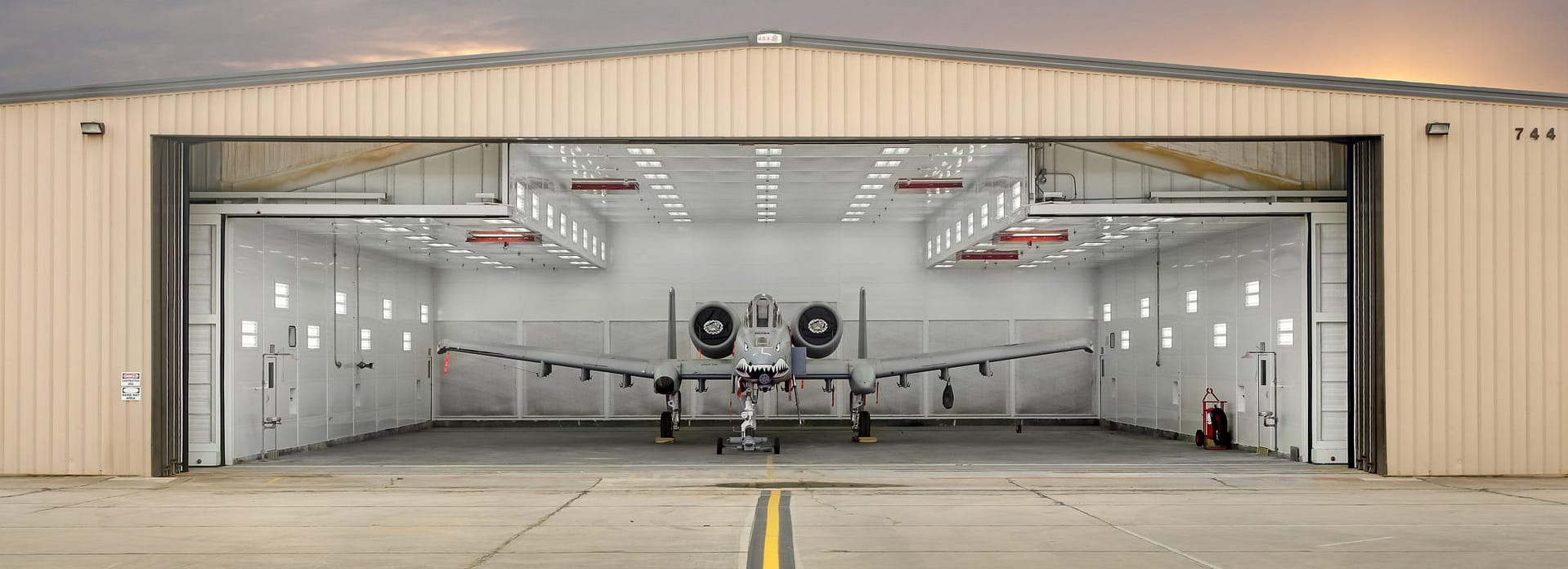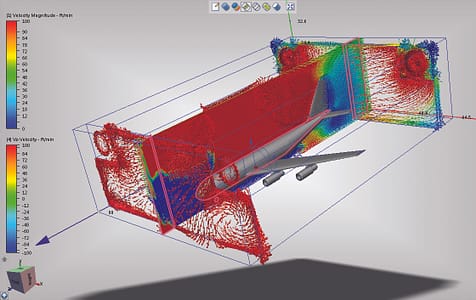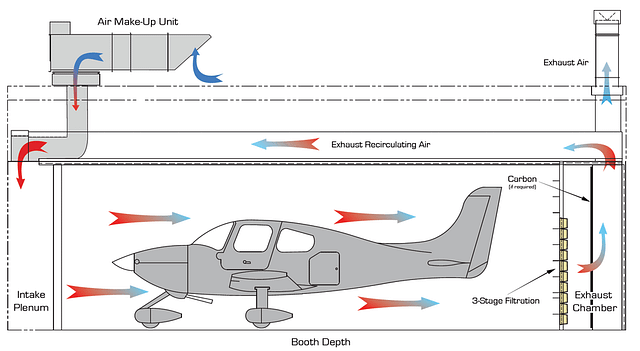
Painting a plane is no small task. Literally. And considering the size and scope of such an undertaking, there are a lot of factors to take into account. You generally have two choices for the structures used for the task: a paint barn or paint booth. While a paint barn may initially seem like a good, cost-effective choice, paint booths offer a plethora of advantages that more than make up for the initial investment.
When we talk about a paint barn, it generally means a hangar or large metal building that meets the minimum standards for ventilation and proper filtering of overspray. Oftentimes, these enclosures aren’t designed with painting in mind. This means airflow has not been optimized for aircraft painting, nor have safety and filtration concerns been made a priority.
Global Finishing Solutions (GFS) offers several options for aircraft paint booths. A paint booth can be designed to fit into an existing hanger structure (paint booth insert) or integrated into a new building structure.
Aircraft paint booths are engineered in a wide variety of airflow configurations. In general, downdraft airflow is the preferred style, as it allows gravity to pull the overspray to a pit in the floor. However, cross draft booths are a popular option for aircraft painting as it is a more cost-effective solution and the airflow pattern matches the natural flow of air across the aircraft. Cross Draft booths make up about 75 percent of all aircraft paint booths that GFS manufactures.
The features of a paint booth play a large role in differentiating it from a paint barn. One of the main, important differences is airflow, which is key to paint finish quality and overall paint shop efficiency. The balanced airflow design of GFS paint booths reduces the presence of dirt and contaminants, and increases overall overspray and volatile organic compound (VOC) removal.

To optimize airflow in an aircraft booth, GFS engineers use Computational Fluid Flow Dynamics (CFD) software. This advanced software allows us to simulate booth airflow performance before the booth is even built. Using modeling, engineers can test out custom designs, and customers can get a preview of how well a booth will perform.
Paint barns, on the other hand, calculate airflow based on the size of the aircraft, despite the fact that there is very limited control of where that air goes within the overall hangar space. Without a nuanced control of the flow, reducing airflow to a more reasonable level for painting degrades the laminar flow in the center of the plane. This degradation allows eddies, or swirls of airflow to form, which become visible as a cloud of overspray in the affected area. Overspray results in poorer paint quality and more rework.
As a paint barn is generally just a spare hangar or a large space which can fit the aircraft to be painted, the interior has not been designed to efficiently deal with overspray and VOC containment. The walls of a paint booth are easily cleanable and smooth to resist contamination buildup. White walls create a brighter painting environment which makes for better quality finishes.
Working in a paint barn, the lighting level is typically low, limited only to ceiling fixtures. Paint booths, on the other hand, allow for lights to be strategically placed to provide a luminous environment for painting around the entire aircraft. Optimal lighting helps eliminate paint runs, dust and dirt inclusions, skipped portions and corroded areas in need of repair.
GFS paint booth lighting is engineered to achieve maximum intensity in the area where paintable surfaces are located. Sidewall lighting provides a highly visible surface to any point on the airplane. This ensures areas where corrosion would originate can be found and repaired.

Safety is an important factor in comparing a paint booth and paint barn. The National Emissions Standards for Hazardous Air Pollutants (NESHAP) requires the use of high efficiency filters to remove 95 percent of particles over 2 microns in size under certain conditions. GFS’ 3-stage filtration system consists of roll media, a MEPT panel filter and a 6-pocket bag filter to provides 99 percent removal of most paint spray aerosols. GFS also offers carbon beds and filters to remove up to 96 percent of VOCs from the airstream. A paint barn needs to meet standards for filtration, but because it isn’t engineered for the task of painting an aircraft like a paint booth is, oftentimes dust will recirculate back into the airflow and can also escape the barn, entering the environment.
Most advanced aerospace coatings are best applied in a narrow temperature range; this requires precise temperature and humidity controls. GFS is a leader at designing the most modern environments with specialized equipment and controls. These systems often have mechanical or evaporative cooling and direct injection steam or evaporative humidity generators.
Whereas with a paint barn you have little control over the environment you are painting in, paint booths can be designed with energy efficiency in mind.
GFS has pioneered the conformal aircraft booth. This design introduces air at a higher velocity in the spraying zone than in non-spraying areas of the paint booth. This provides excellent painting performance, while minimizing the amount of air and energy required for the process. The design can result in a savings of 15 to 30 percent in capital and operating costs when compared to that of a traditional booth design or paint barn.

As air is exhausted during the painting process, conditioned air is also lost. GFS offers energy recovery systems that reclaim a portion of that air, in turn providing measurable energy savings. On average, these systems provide 40 to 50 percent energy savings for air make-up systems serving the booth for both heating and cooling. In addition, GFS can also provide a recirculated air system for its booths that provides accurate control of the booth climate and airflow, while reducing operating and equipment costs.
A paint barn might at first seem like an ideal option: with little investment, you can just wheel a plane into a spare hangar and get painting. Less ideal is the several days of extra labor spent on rework and repairing defects in the coating. Nor is inadequate filtration to protect not only painters and personnel, but also the environment.
GFS aircraft paint booths are designed and engineered with the following in mind: safety, airflow, temperature and humidity control, contamination control, lighting and energy efficiency. Painting in an engineered, proven paint booth allows you to achieve first-pass quality paint finishes, and protects your aircraft and painters from potential contamination and health hazards. Conformal airflow and recirculating booth designs, as well as energy recovery systems, allow you to achieve significant energy savings.
Ultimately, there are applications that only call for a paint barn and those more suited to a paint booth. Overall, we believe that the benefits of investing in a state-of-the-art aircraft paint booth outweigh the initial cost savings of using a paint barn in most cases.
One of the best ways to highlight your business is through a story that you can share across your online platforms. It humanizes your business and shows that your business can make a meaningful impact. Your testimonial would be used as a project profile on the GFS Booth Blog and can be shared on your website and/or social media channels.
Complete this form and we’ll be in touch to showcase your company.

Shop a variety of GFS aftermarket products, including booth protection products and mobile accelerated curing units. And enjoy the convenience of fast and free ground shipping throughout the contiguous United States.

Located at GFS’ headquarters in Osseo, Wisconsin, the Center for Excellence is an innovative facility featuring an automotive refinish training center, as well as a separate space dedicated to technical product training.

GFS is continuously searching for talented, ambitious individuals to join our team. We aim to provide our employees with every opportunity to make an impact on the company and find their niche along the way — weather in a production, field services or an office position.